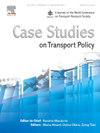Unveiling Route Choice Preferences and Classifying Travelers Based on Distinct Travel Patterns Using Trajectory Data
IF 2.4
Q3 TRANSPORTATION
引用次数: 0
Abstract
Effective travel demand management strategies hinge on a better understanding of route choice behavior. This complexity is further intensified by the diversity of activity patterns and the intricate structure of urban networks, posing significant challenges to conducting and interpreting large-scale, detailed analyses of drivers’ travel preferences. The rapid adoption of electric vehicles (EVs) equipped with positioning systems enables the collection of large-scale individual travel data and the observation of repetitive travel patterns, offering new opportunities to analyze travel preferences. Utilizing anonymized trajectory data from 4,551 family-operated EVs in Shanghai, this study delves into travelers’ route choice preferences and identifies distinct traveler types. We introduce the concept of an entropy-weighted propensity score to capture the heterogeneity in travelers’ preferences for various route characteristics and examine these preferences across different travel scenarios – including trip distance, trip types, periods of departure time, origin and destination locations, and land use mix. Furthermore, we propose a sample-weighted K-means clustering method to categorize travelers into three distinct types: those exhibiting high travel variability with low rationality, low travel variability with medium rationality, and high travel variability with high rationality. Our findings deepen the current understanding of route choice behaviors and could provide empirical support for enhancing the precision and effectiveness of route choice models. When examining route choice behavior, it is essential to account for conventional fuel vehicles and to critically assess the distinctions between them and EVs. Moreover, they offer practical insights for alleviating traffic congestion through personalized active traffic demand management strategies.
利用轨迹数据揭示路线选择偏好和基于不同出行模式的旅行者分类
有效的旅行需求管理策略取决于对路线选择行为的更好理解。活动模式的多样性和城市网络的复杂结构进一步加剧了这种复杂性,这对进行和解释驾驶员出行偏好的大规模、详细分析提出了重大挑战。配备定位系统的电动汽车(ev)的迅速普及,使得大规模个人出行数据的收集和重复出行模式的观察成为可能,为分析出行偏好提供了新的机会。本研究利用上海4551辆家庭式电动汽车的匿名轨迹数据,深入研究了旅行者的路线选择偏好,并确定了不同的旅行者类型。我们引入了熵加权倾向得分的概念,以捕捉旅行者对各种路线特征偏好的异质性,并在不同的旅行场景(包括旅行距离、旅行类型、出发时间、出发地和目的地以及土地使用组合)中检查这些偏好。此外,我们提出了一种样本加权k均值聚类方法,将旅行者分为三种不同的类型:低理性的高旅行变异性、中等理性的低旅行变异性和高理性的高旅行变异性。本文的研究结果加深了人们对路径选择行为的认识,为提高路径选择模型的准确性和有效性提供了实证支持。在研究路线选择行为时,必须考虑到传统燃料汽车,并严格评估它们与电动汽车之间的区别。此外,它们为通过个性化的主动交通需求管理策略来缓解交通拥堵提供了实用的见解。
本文章由计算机程序翻译,如有差异,请以英文原文为准。
求助全文
约1分钟内获得全文
求助全文

 求助内容:
求助内容: 应助结果提醒方式:
应助结果提醒方式:


